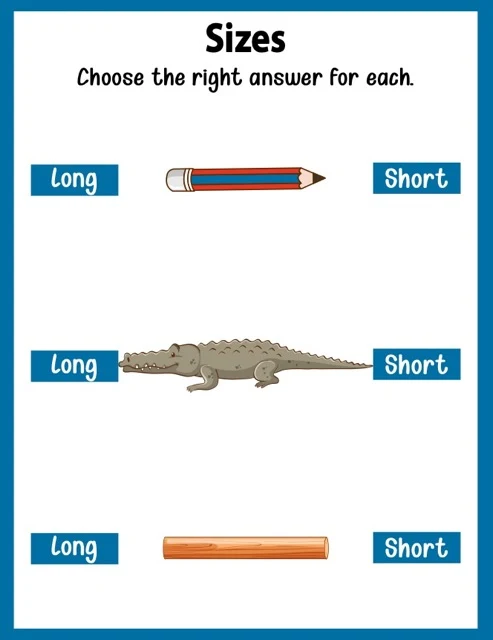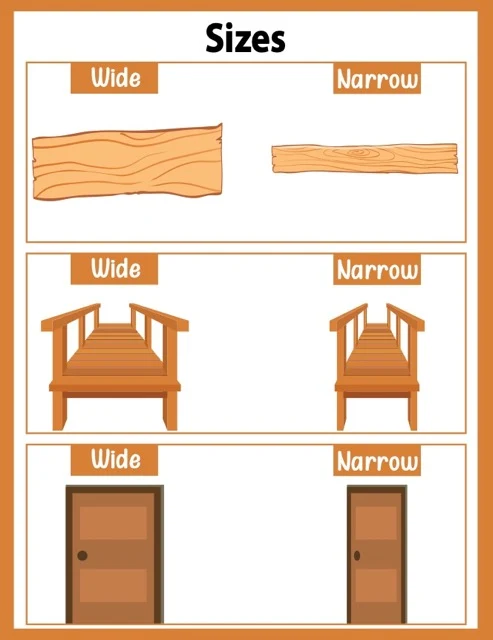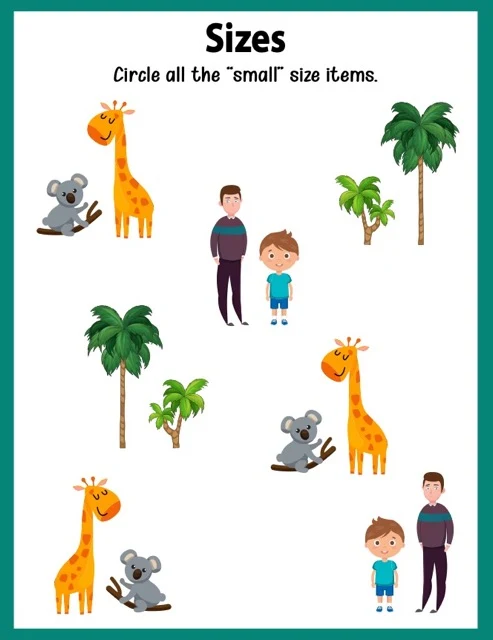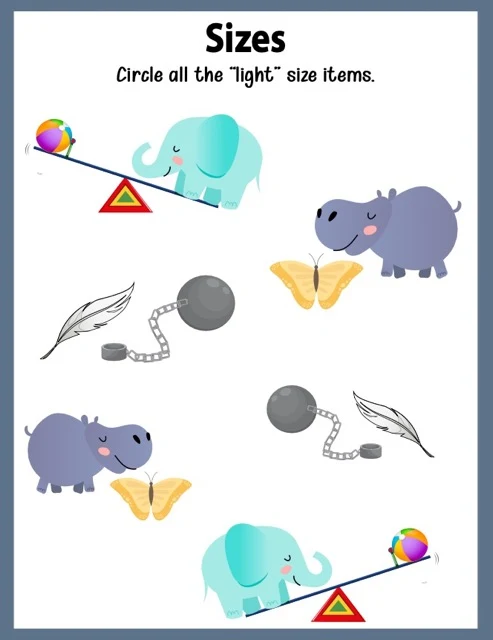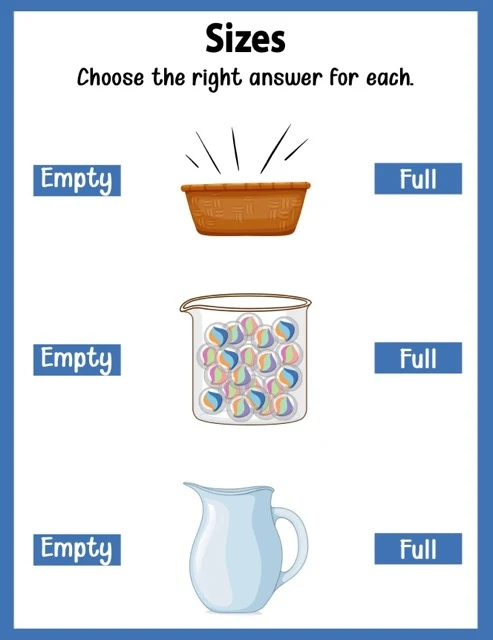Understanding Size: A Comprehensive Guide
This document set explains the concept of size, emphasizing its relative nature and importance in various fields. It defines size through measurable dimensions and visual comparisons, highlighting its role in spatial awareness, object recognition, and problem-solving. The materials also explore size's impact on design, art, and functionality, and offer teaching methods for children, including hands-on activities and visual aids. A study guide and glossary further support understanding of this fundamental concept.
Understanding Size: A Comprehensive Guide
Briefing Document: Understanding the Concept of Size
Theme: This document explores the concept of size, its relative nature, its importance in various domains, and methods of teaching it.
Key Sources:
●
"Testing Theme: Sizes.pdf" (Visual Aid)
●
"Understanding Size" (FAQ)
●
"Understanding Size: A Study Guide" (Study Guide & Glossary)
Main Ideas:
1.
Definition of Size: Size refers to an object's physical dimensions, indicating its largeness or smallness. It's determined by measurable proportions like length, width, and height. ("Understanding Size" FAQ)
2.
Visual Representation: Size is visually represented by comparing objects of varying dimensions. Larger objects occupy more space, while smaller objects appear compact. ("Understanding Size" FAQ & "Understanding Size: A Study Guide" Short Answer Key #1)
3.
Relativity of Size: An object's perceived size is relative and depends on the context of comparison. For example, a car might seem large next to a bicycle but small compared to an airplane. ("Understanding Size" FAQ & "Understanding Size: A Study Guide" Short Answer Key #2)
4.
Importance of Understanding Size: Understanding size is crucial for:
○
Spatial Awareness: It allows us to perceive and navigate the space around us effectively. ("Understanding Size" FAQ & "Understanding Size: A Study Guide" Short Answer Key #3)
○
Object Recognition: We identify and categorize objects based on their size.
○
Problem-Solving: We make decisions based on size comparisons, such as choosing the right container for storage. ("Understanding Size" FAQ & "Understanding Size: A Study Guide" Short Answer Key #10)
5.
Impact of Size on Functionality: An object's size often dictates its purpose. A small container might hold spices, while a larger one is needed for grains. Size influences capacity and suitability for various tasks. ("Understanding Size" FAQ & "Understanding Size: A Study Guide" Short Answer Key #4)
6.
Size in Design and Art: Size is used to create:
○
Visual Hierarchy: Larger elements attract more attention than smaller ones.
○
Emphasis: Specific elements are highlighted using size variations.
○
Balance: Size relationships contribute to a visually harmonious composition. ("Understanding Size" FAQ & "Understanding Size: A Study Guide" Short Answer Key #5)
7.
Teaching Children About Size:
○
Hands-on Activities: Sorting, comparing, and ordering objects of different sizes using household items like spoons, cups, and books. ("Understanding Size: A Study Guide" Short Answer Key #7)
○
Visual Aids: Picture cards, interactive games, and the "Testing Theme: Sizes" visuals. These visuals effectively demonstrate size differences across various object categories. ("Understanding Size: A Study Guide" Short Answer Key #6, #9)
Supporting Quotes:
●
"Size is visually represented by comparing objects of different dimensions." ("Understanding Size" FAQ)
●
"Size is relative because an object's perceived size depends on the context and what it's being compared to." ("Understanding Size" FAQ)
●
"The 'Testing Theme: Sizes' visuals represent the concept of size by showcasing a range of objects across different categories and directly comparing their dimensions." ("Understanding Size: A Study Guide" Short Answer Key #6)
Further Exploration:
●
The "Understanding Size: A Study Guide" provides essay questions exploring relative size, size in design/architecture, size's role in child development, and the impact of technology on our understanding of size.
●
A glossary of key terms related to size is also included in the study guide.
Conclusion: Understanding size is fundamental for navigating our world, solving problems, and appreciating the visual arts. By using diverse methods, we can effectively teach this concept to children, equipping them with essential cognitive skills.
Understanding Size
FAQ: Understanding the Concept of Size
1. What is the basic concept of size?
Size refers to the physical dimensions of an object, indicating how large or small it is. It's a way of comparing and contrasting objects based on their measurable proportions.
2. How is size visually represented?
Size is visually represented by comparing objects of different dimensions. Smaller objects appear compact, while larger objects occupy more space. The contrast in their visual dimensions highlights the concept of size.
3. Can you provide examples of size comparisons across different categories?
●
Furniture: A single bed is smaller than a queen-size bed.
●
Animals: A cat is smaller than a bear, and a bear is smaller than an elephant.
●
Transportation: A car is smaller than a bus, and a bus is smaller than a cruise ship.
●
Natural elements: A pebble is smaller than a rock, and a rock is smaller than a mountain.
4. How is size relative?
Size is relative because an object's perceived size depends on the context and what it's being compared to. For example, a car might appear large compared to a bicycle, but small compared to an airplane.
5. What is the importance of understanding size?
Understanding size is crucial for various tasks, including spatial awareness, object recognition, and problem-solving. It allows us to make informed decisions based on the physical dimensions of objects and their relationships.
6. How does size impact functionality?
Size often dictates an object's functionality. A small container might be suitable for storing spices, while a larger one is needed for storing grains. Similarly, a small car is easier to maneuver in tight spaces, while a larger vehicle offers more passenger and cargo capacity.
7. How is size used in design and art?
In design and art, size is used to create visual hierarchy, emphasis, and balance. By manipulating the size of elements, artists and designers can guide the viewer's attention and evoke different emotions.
8. How can children be taught about size?
Children can be taught about size through hands-on activities involving sorting, comparing, and ordering objects of different sizes. Visual aids, like picture cards and interactive games, can also effectively illustrate the concept of size.
Understanding Size: A Study Guide
Understanding Size: A Study Guide
Short Answer Quiz
Instructions: Answer each question in 2-3 sentences.
1.
How is size visually represented?
2.
Provide two examples of how size can be relative.
3.
Why is understanding size important for spatial awareness?
4.
How does size impact functionality? Provide an example.
5.
How is size used in design and art?
6.
How do the "Testing Theme: Sizes" visuals represent the concept of size?
7.
Describe a method for teaching children about size using household objects.
8.
What is the difference between a "small" object and a "large" object?
9.
Explain how the "Testing Theme: Sizes" visuals could be used as a learning tool.
10.
How can an understanding of size help in problem-solving situations?
Short Answer Quiz Answer Key
1.
Size is visually represented through the comparison of objects with different dimensions. Smaller objects appear to take up less space, while larger objects appear to take up more space. The contrast between these visual dimensions highlights the concept of size.
2.
A car might appear large when compared to a bicycle, but small when compared to an airplane. A house may appear large compared to a person, but small compared to a skyscraper.
3.
Understanding size is essential for spatial awareness because it allows us to perceive and navigate the space around us effectively. It enables us to judge distances, avoid obstacles, and understand the relationships between objects in the environment.
4.
Size often dictates an object's functionality. For example, a small container might be suitable for storing spices, while a larger one is needed for storing grains. The size difference affects the container's capacity and suitability for different purposes.
5.
In design and art, size is used to create visual hierarchy, emphasis, and balance. Artists and designers can guide the viewer's attention and evoke different emotions by manipulating the size of elements within a composition. Larger elements tend to attract more attention, while smaller elements may recede into the background.
6.
The "Testing Theme: Sizes" visuals represent the concept of size by showcasing a range of objects across different categories and directly comparing their dimensions. Each visual clearly demonstrates the difference in size between two objects, allowing viewers to grasp the concept of relative size.
7.
To teach children about size using household objects, you could gather a variety of items such as spoons, cups, and books of different sizes. Have the child sort the objects from smallest to largest or vice versa. This hands-on activity helps children develop their understanding of size comparisons.
8.
The difference between a "small" object and a "large" object is relative and depends on the context of comparison. However, in general, a "small" object has smaller dimensions and occupies less space than a "large" object, which has larger dimensions and occupies more space.
9.
The "Testing Theme: Sizes" visuals could be used as a learning tool by presenting them to learners and initiating discussions about the relative sizes of the objects depicted. Learners could be asked to explain their understanding of the size comparisons shown in the visuals and provide additional examples of objects of different sizes from their own experiences.
10.
An understanding of size can help in problem-solving situations by enabling us to assess the suitability of objects for specific tasks or environments. For example, when packing a suitcase, we consider the size of the items we need to pack and the size of the suitcase itself to ensure everything fits properly.
Essay Questions
1.
Discuss the concept of relative size and explain how our perception of size can change based on context. Provide examples to illustrate your points.
2.
Analyze the role of size in design and architecture, focusing on how architects and designers use size to create functional and aesthetically pleasing spaces.
3.
Explore the importance of understanding size in childhood development, highlighting how it contributes to cognitive and motor skills development.
4.
Evaluate the effectiveness of different methods for teaching children about size, discussing the advantages and disadvantages of various approaches.
5.
Explain how technology has impacted our understanding of size. Discuss the ways in which digital tools and virtual environments have influenced our perception and manipulation of scale.
Glossary of Key Terms
Size: The physical dimensions of an object, indicating how large or small it is.
Dimensions: Measurable extents of an object, such as length, width, and height.
Relative Size: The perceived size of an object in comparison to other objects or its surrounding environment.
Visual Hierarchy: The arrangement of elements in a design to guide the viewer's attention, often achieved through variations in size, color, and contrast.
Spatial Awareness: The ability to perceive and understand the space around us and the relationships between objects in that space.
Functionality: The purpose or use of an object, often determined by its size, shape, and material.
Scale: The relative size of an object compared to a standard unit of measurement.
Proportion: The harmonious relationship between the sizes of different elements within a composition.
Emphasis: Drawing attention to a particular element in a design, often achieved through size, color, or placement.

